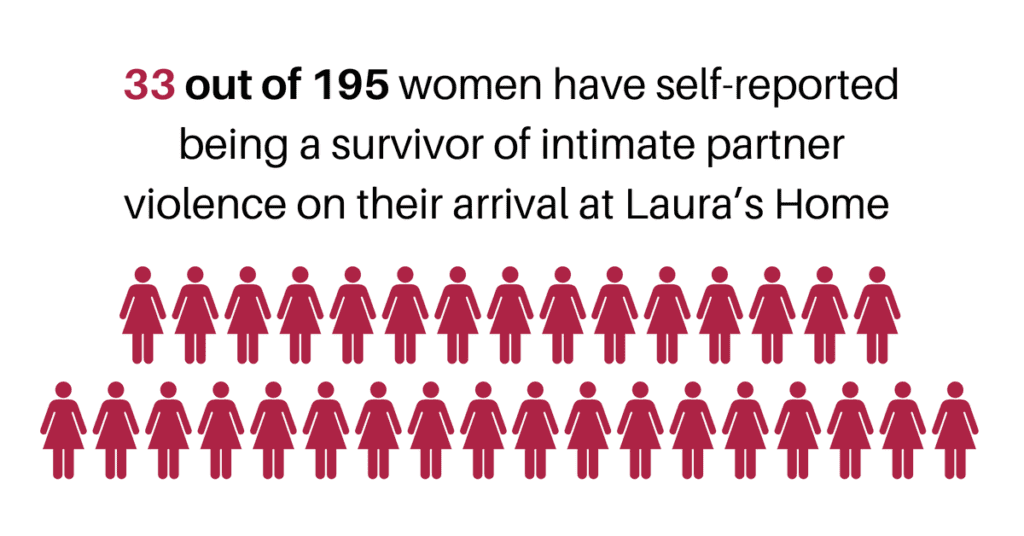What Would You Choose?
If you were stuck in a manipulating, violent, and dangerous situation, you would immediately leave, right? Not necessarily; unfortunately, due to the nature of intimate partner violence (historically referred to as domestic violence) those being abused don’t always feel like they have the option to escape.
Chanelle’s Story
Chanelle, like many survivors of intimate partner violence, had to make the impossible choice to either stay in a life-threatening home situation or leave for a very uncertain future. As the abuse in her marriage grew, she came to realize she could not allow her children to grow up in this unhealthy environment. She considered turning to Laura’s Home Women’s Crisis Center, a long-term wraparound service program in Cleveland, but was reluctant because she thought of it as a homeless shelter; and she wasn’t currently homeless.
As time went on, Chanelle’s situation progressively worsened – they couldn’t pay rent, and her crisis became more than she could handle on her own. Courageously, she called Laura’s Home for days until they were able to offer her an open spot.
“They called me, and I got everything ready so my husband wouldn’t notice I was up to something. I stood there crying because I knew there was no turning back. My flesh wanted to stay, but I said, ‘No, I’m going to trust this and walk through these doors.’”
Chanelle found refuge at Laura’s Home, where she and her children were accepted and protected.
“I was scared, but as soon as I walked in, they welcomed me, and I knew it was God who sent me to Laura’s Home.”
She had been feeling trapped under the captivity of her abuser, her husband, a horrifying reality that many women face.
Just in this past year, 33 out of 195 women have self-reported being a survivor of intimate partner violence on their arrival at Laura’s Home, with many others disclosing this fact later on in their stay. Unfortunately, feelings of shame or fear of stigma associated with intimate partner violence keep many from reporting it, leaving it difficult to measure with exact precision.
The Ohio Bureau of Criminal Identification and Investigation Domestic Violence Reportfor 2017 showed that there were a total of 7,482 domestic violence incidents reported in Cuyahoga County in that year; 3,530 of those reports were just through the Cleveland Police Department[i]. Alone, in the state of Ohio, there was a total of 76,416 Domestic Dispute Calls in 2017.[ii]These are tragic numbers that cannot be ignored.
What is Intimate Partner Violence?
Intimate Partner Violence, also commonly known as domestic violence, is defined by the Centers for Disease Control and Prevention as “physical violence, sexual violence, stalking and psychological aggression (including coercive acts) by a current or former intimate partner.” This type of violence can vary in frequency and severity, occurring on a continuum which can range from one mild episode to multiple chronic and severe episodes over years.[iii]The patterns of abusive and violent behaviors, seen in many forms, are used by one partner to maintain power and control over the other partner. This type of violence does not discriminate, as it is seen between anybody of any race, age, gender, sexual orientation, religion, socioeconomic background, and education level.[iv]
Despite the parties involved and what their specific situation may be, abuse is unacceptable and never justified.
Why not just leave?
Those who have never experienced abuse or are unfamiliar with this type of violence may wonder why a person wouldn’t just leave the relationship or situation. The reality is, leaving is not only complicated, but also one of the most dangerous times for a victim of intimate partner violence. As abusers go to extremes to prevent victims from leaving, they very well could follow up on the extreme threats used to keep the victims trapped. Just as Chanelle was terrified of escaping her husband, many victims of abuse face various obstacles to leaving. The National Domestic Violence Hotline presents a few of the very common, yet complex reasons why a victim may stay[v]:
- Fear: A person might fear what could happen before, during, or after leaving.
- Believing Abuse is Normal: A person may not recognize that their relationship is unhealthy, and may not know what a healthy relationship should look like.
- Embarrassment or Shame: It can be very difficult for a victim to admit and share about their abuse. They may feel confused and as if they have done something wrong; they worry about judgment or denial from others.
- Low Self-Esteem: After the abuser has been putting down and blaming the victim, it can be easy for them to believe what they have been told, leaving them with a diminished confidence.
- Love: Abusive people can often be quite charming, especially at the beginning of the relationship, which is probably a reason why the relationship began in the first place. Often, the victim is confused by their love for the abuser, remembering how they used to be, possibly wanting the abuse to end, but not the entire relationship.
- Lack of Money/Resources: Especially with the commonality of financial abuse, a victim could be completely dependent on their abusive partner financially. Without money, access to resources, or a place to go, it almost seems impossible for a victim to escape, leaving them feeling helpless and stuck.
The #1 Reason for Staying
Dr. Dara Richardson-Heron, CEO of the YWCA USA, examines the number one reason that victims of intimate partner violence do not leave abusive relationships: a lack of financial resources and options.[vi]While all financial abuse prevents the survivor from reaching financial stability and independence, it can take on many forms, including but not limited to the following examples:
- Abusers may forbid their partners to work
- Work might be permitted, but the abuser places the paychecks into their own account
- Restriction of access to credit cards and personal bank accounts
- Shared access to a credit card or bank account, with close monitoring and threats
- A provided allowance with restrictions on how it is spent
- Maxing out credit cards in the victim’s name, or not paying bills – ruining their credit scores
- Stealing money from the victim or their family and friends
- Refusing to give the victim money to pay for necessities or shared expenses
The list could go on and on, as financial abuse impacts nearly 98% of all intimate partner violence victims,[vii]and with it comes many long-term consequences and hardships for survivors. With the combination of broken relationships and financial crisis, intimate partner violence is actually the third leading cause of homelessness among families in the country,[viii]making places like Laura’s Home a safe haven for many in the Cleveland area.
If a survivor courageously decides to escape their situation, where will they be able to go with no money, job, or financial resources? In Chanelle’s case, she was able to safely escape her situation and make a new life for her and her children at Laura’s Home. Unfortunately, Laura’s Home and the few other organizations that provide special assistance to IPV survivors are full. And the need for both men and women’s programs with full care services, especially for survivors, is critical. For people in abusive relationships, knowing that there areplaces to go and people to help them could be the difference between life and death.
The City Mission is just one of the safe places where survivors can come to get away from their abuser, and they believe that better support comes from better understanding.
Laura’s Home takes clients’ histories of Intimate Partner Violence seriously. Clients’ stays are confidential, meaning if anyone were to inquire whether a woman was staying at Laura’s Home, that information would not be disclosed. At Laura’s Home, classes are offered to help clients reflect on areas of their lives needing healing and change, teach them about healthy relationships, and introduce them to new skills to use for a healthier life. The entire community at Laura’s Home, both staff and other clients, aid in the healing journey as they hear others’ stories and can relate and support each other. A caseworker is assigned to each client to help identify necessary resources, often referring clients to outside agencies to provide further help. Individual counseling is a common resource to help clients process what they have been through and move toward stable independence.
Because people often do not understand the dynamics of abuse, there is a stigma, resulting in a lack of support or unintentional harm to survivors. In order to do better and empower more survivors, it is critical for the entire community to become more educated about Intimate Partner Violence.
While Laura’s Home continues to fight the battle against IPV and homelessness, the organization hopes Cleveland will step up in greater ways to help women and children in crisis. Staff members of The City Mission believe that if the Mission were to expand, there would be both greater space and opportunities to bring in more education, support groups, and outside agencies for specialized services for survivors. With hundreds of women and children experiencing homelessness in our city every night, there is a desperate need to support such growth in order to keep on empowering families and individuals in our community to overcome their past and move toward a brighter, safer future.
If you would like to learn more about how to assist victims who come to The City Mission, visit our How You Can Help page.
For those seeking help:
Domestic Violence and Child Advocacy Center, Cleveland
(216) 229-2420, or (216) 391-HELP(4357) for 24-hour help
The National Domestic Violence Hotline
1-800-799-SAFE (7233)
References
[i]https://www.ohioattorneygeneral.gov/Law-Enforcement/Services-for-Law-Enforcement/Domestic-Violence-Reports/Domestic-Violence-Reports-2017/2017-Domestic-Violence-Incidents-by-County-and-Age
[ii]https://www.ohioattorneygeneral.gov/Law-Enforcement/Services-for-Law-Enforcement/Domestic-Violence-Reports/Domestic-Violence-Reports-2017/2017-Domestic-Dispute-Calls
[iii]https://www.cdc.gov/violenceprevention/intimatepartnerviolence/definitions.html
[iv]http://www.thehotline.org/is-this-abuse/why-do-people-abuse/
[v]http://www.thehotline.org/is-this-abuse/why-do-people-stay-in-abusive-relationships/
[vi]https://www.huffingtonpost.com/dr-dara-richardsonheron/economic-empowerment-is-c_b_7792540.html
[viii]https://www.acf.hhs.gov/domestic-violence-and-homelessness





